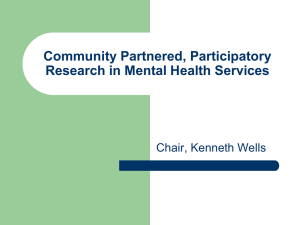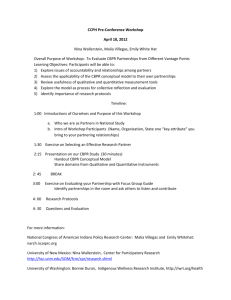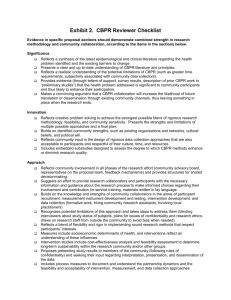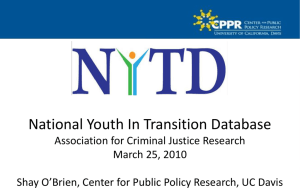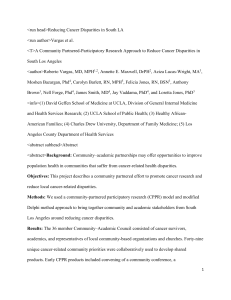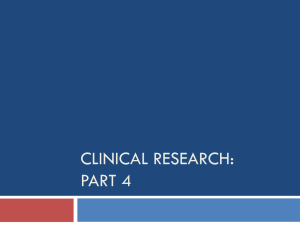Community Partnered, Participatory Research in Mental Health Services Community-based Participatory
advertisement
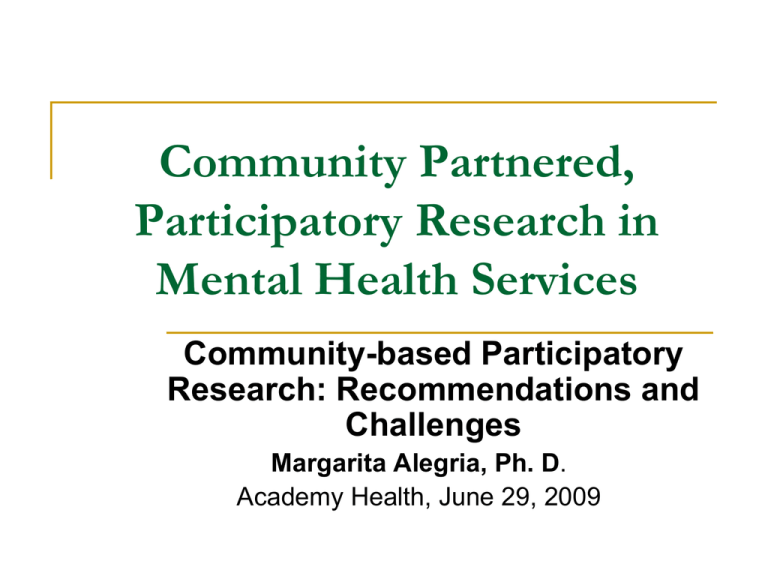
Community Partnered, Participatory Research in Mental Health Services Community-based Participatory Research: Recommendations and Challenges Margarita Alegria, Ph. D. Academy Health, June 29, 2009 Creating Communities of Practice July 24-25, 2006, held conference to gather teams of researchers from NIMH centers for mental health research from UCLA/RAND, Georgetown University, Cambridge Health Alliance, and Washington University in St. Louis with their community partners Creating Communities of Practice Discuss opportunities and challenges in partnered research Strategize for future directions in developing CPPR as part of focus on community impact in MH services research Effort to expand field of partnered research for quality improvement in mental health Recommendations Structuring the Partnership Setting Up the CPPR Project Developing Creative Dissemination Training Recommendations Structuring the Partnership Forming partnerships so that it is a win-win situation for everyone Acknowledging and communicating different goals and needs of community versus those of investigators not only as the partnership is getting structured but as it progresses Necessary to develop strategies to better understand each others worlds-community members to understand what research has to offer and for researchers to sit in community advisory boards learning about community Recommendations Structuring the Partnership Recognize there will be shifts in power structure during different parts of project Celebrate small victories as a way to sustain the partnership Integrate support for leadership development, knowledge transfer and data dissemination Recommendations Setting Up the CPPR Project Make expectations about each group’s role clear from early phases of project so that groups are not disappointed with tasks and process as it unfolds Outline objectives of project from very beginning in terms of goals for community and for institution Establish consensus on who should lead CPPR/ grant application and under what circumstances. In ongoing relationships, partners should take turns in leading grant applications. At the same time, becoming aware of funding agency’s agenda is critical to ensure success of the CBPR project Recommendations Setting Up the CPPR Project Developing consensus on outcomes of CPPR and clarifying how data collected might benefit partners Ensuring community has access to the data and results of project Restructure grants so that financial equity is part of funding criteria Require all grants conduct partnership evaluation, along w/ other evaluations relative to process of implementing partnership Institutionalize partnership or at least develop sustainable infrastructure for partnership to continue after research has been completed Recommendations Setting Up the CPPR Project Pay attention to end user to make sure information has relevance, sustains community interest and engagement Salient to sustain trust among stakeholders, maintaining communication and transparency Recommendations Developing Creative Dissemination Dissemination for program development, methods to evaluate outcomes and partnership success. Publication of process papers on community engagement and partnerships by groups already involved as well as information of what works and what doesn’t work in partnerships Sharing success stories of CPPR w/ policy makers Assisting media in framing different encounters from mental health perspective and from social activism perspective Recommendations Developing Creative Dissemination Description of developmental Importance of advocacy as stages of partnership and part of dissemination manuals of lessons learned strategies and marshalling community support Development of toolkit on Joint presentations and how to adapt and publications by partners and disseminate evidencerecognition of role of based practices in the community organizations in success of community based community to establish “community validity.” research Recommendations Training NIH training for community partners Continue to have special NIMH reviews with CPPR experts for CPPR applications Workshops should be provided to train young investigators in CPPR methods, including processing the data so it is useful to community agencies Challenges in Successful CPPRs 1. 2. 3. When criteria for CPPR successful collaboration is at odds w/ scientific criteria for successful funding: Outcomes-illness vs. Sx/Wellness Time-funding cycle Design-contamination, case management services, randomization Lack of infrastructure to facilitate efficient budget management of project from community groups Flexibility in negotiating something concrete at the same time vagueness is penalized for not being scientific Stigma-PC of CBPR rather than the need Challenges in Successful CPPRs View of short term investment vs. long term investment in outcomes. Difficulty showing community impact w/ limited resources for evaluation and dissemination Perception of CPPR as a soft science, low value Risky career choice for young investigatorspublication record, where to get things publish, how to convince Dept Chairs good investment of time The Token CBPR group in grants Measurement of Impact of CBPR, doe sit matter
